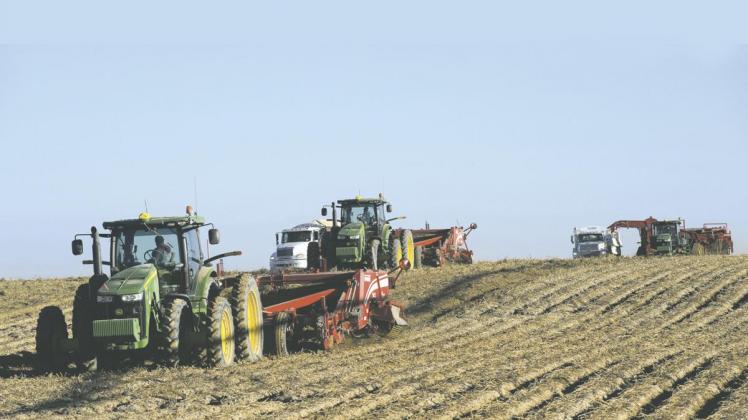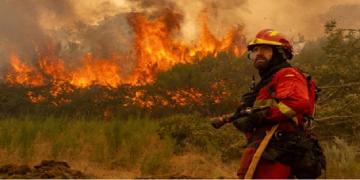EEUU: Idaho potato harvest kicks into gear, yielding variable results
Hot, dry and smoky with a side of quality Idaho potatoes. Though the previous sentence reads like a partial picnic recipe, it’s a succinct (and savory) description of the 2018 potato-growing season that is just beginning to kick into high gear.

The eastern Idaho summer has been hot and dry this year. While little more than a half-inch of rain fell across the eastern part of the state since the first of July, growers did not lack for water due to a plentiful snowpack this past winter that supplied the major storage reservoirs of the Upper Snake River Basin with sufficient irrigation water. Even at this late date, the Bureau of Reclamation reports that the Upper Snake River storage system is at 50 percent of capacity.
Initial reports from growers across eastern Idaho indicate a quality crop that may be a little small in profile and an average or slightly lower yield.
Frank Muir, president and CEO of the Idaho Potato Commission, said that Idaho’s annual harvest averages around 13 billion pounds of potatoes, resulting in 412 pounds of Idaho potatoes, fresh, frozen and dehydrated being sold every second.
Muir said that during the past year, the IPC has been emphasizing to growers and packing sheds the importance of maintaining consistent quality in the Idaho brand.
Muir said that the IPC is working with two University of Idaho researchers, Mike Thornton and Nora Olsen, to help promote quality measures in harvesting and storage of Idaho potatoes by producing posters and videos.
“We’ve developed some very clear top 10 things to improve on quality both on the harvesting side and the shipping and handling side,” Muir said. “We actually have videos online now and they’re in Spanish as well to communicate to a lot of our workers who speak primarily Spanish.”
Travis Blacker, industry relations director for the commission, said that as of Monday, a majority of potatoes remain in the ground and a majority of growers will begin their harvest operations next week.
He said that early harvest reports on Russet Norkotahs, one of the first varieties to be harvested annually, indicate a good crop with promising size profile and excellent quality.
Preliminary reports on Russet Burbanks, however, are not as promising.
“Most growers of the Burbanks are a little skeptical on the size,” Blacker said. “Seems like the Burbanks maybe have struggled a little bit this summer with some of the heat and the smokiness. I think that they’re happy with the quality of the Burbanks but as far as the size, they’re hoping that they’ll bulk up but not sure until they get them out of the ground.”
Blacker said that preharvest digs indicate that Russet Burbank yields may be down this year but that the quality is looking good.
The USDA’s National Agricultural Statistics Service acreage report released in June showed a 5,000-acre production increase for Idaho this year compared to 2017’s total of 310,000 acres.
Blacker attributed the increase to the expansion of the McCain Foods processing plant in Burley. In fact, Blacker said that the plant expansion could take more than the 5,000-acre increase and that Idaho fresh potato shipments could be lower than last year’s shipments.
Jared Wattenbarger, of Shelley, said that his family farm had harvested about 100 acres of Norkotahs last week and would begin digging Burbanks today.
Wattenbarger said that the size and quality of the Norkotahs was good but he also expressed some concern for Burbanks.
“I would say that the quality is good,” he said. “The size is probably better than average. Our yields on our later-planted potatoes are not as good as the yields on our earlier-planted potatoes. I don’t have the set. A little bit less set on half my crop and pretty good size average set on the first ones planted. Quality is great we just don’t have the set and the yield on the last few plantings.”
Wattenbarger said he thinks yields will be normal on the early-planted varieties but he predicted yields could be down 5 percent on varieties planted later in the spring.
Another Shelley grower, Merrill Hanny, works his harvest around the Shelley High School annual harvest break that begins Monday and last for two weeks.
“The crop looks smaller to me, profile wise,” Hanny said. “What has really changed the whole thing is the smoke we had in August. It really played with the plants ability to use the photosynthesis to grow.”
Hanny said that he thinks yields will be slightly down this year.
“Not only the profiles but the total production per acre. I think it will be down a little bit. If this profile is smaller, carton prices will be really strong,” he predicted.
According to Kent Peterson, vice-president of raw product for Wada Farms, they started digging Norkotahs in the Fort Hall area on Aug. 26 and they just started digging in the Michaud Creek and Arbon Valley areas this past week.
“The crops looking good. I would say it’s probably average, decent size,” Peterson said Monday.
He said that they have been harvesting Norkotahs and just started Monday on the Burbanks, which were a little smaller but the quality is good.
“We had a little bit of an issue with the smoke and stuff like that and getting them to finish out a little bigger on the back end,” Peterson said.
“We’re digging on the Michaud and Arbon Valley area those are looking real good,” he said. “Those are all our fry varieties down there, they’re looking really, really, good. Good quality, good size.”
Dan Hargraves, an industry consultant for process growers, said that early processing varieties were of average size and showing good quality but that the Russet Burbank yields will determine what kind of market the process growers will have this year.
“There was a lot of weather variability and heat and I think that’s probably going to translate into some variability in yields and quality in all varieties but mostly in Russet Burbanks,” Hargraves said. “Some of these new processing varieties can handle the heat better. They aren’t as sensitive to prolonged hot temperatures as the Russet Burbank is. ”
Fuente: https://www.postregister.com/farmandranch/crops/potato-harvest-yielding-variable-results/article_ca9754a5-6ae2-5d24-a506-33d18dd721f5.html







